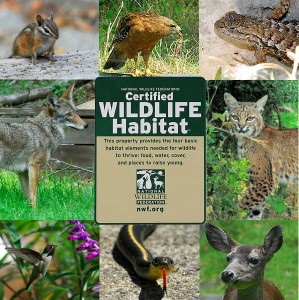On November 2nd, 2009, Curbstone Valley Farm became a Certified Wildlife Habitat by the National Wildlife Federation. As much as we joke about the deer devouring the vegetation, gophers gnawing their way from one end of the property to the other, and rampaging rabbits absconding with our produce, all this activity is indicative of the abundant wildlife that loves to call our tiny farm home.
We are fortunate to reside within a fully functioning and thriving ecosystem, and we intend to preserve it with as little impact on the land, or its inhabitants, as possible, in an effort to maintain the diverse array of plant, animal, and insect life here.
We chose this property in large part because it’s situated amidst a large tract of natural woodland. During the day we often catch glimpses of passing deer, coyotes, bobcats, or red-shouldered hawks within just a few feet of our windows. At night the canyon behind the house is filled with the soothing sounds of Great Horned and Western Screech Owls calling to each other along the ridge tops.
Our farm is home to a truly impressive array of animal species. Some of the reptiles and amphibians that can be found here include Santa Cruz garter, Pacific gopher, California mountain king, and Pacific ring-necked snakes, Skilton’s skinks with their stunning blue tails, fence and alligator lizards, coast range newts, and Northern Pacific treefrogs.
Birds are in abundance too, including the Great Horned and Western Screech owls, Juncos, Warblers, Wrens, House Finches and Goldfinches, Stellar’s and Scrub Jays, Northern Flickers, Acorn and Pileated woodpeckers, California Quail, Chickadees, Towhees, and Hummingbirds, just to name a few.
Deer, bats, rabbits, moles, voles, gophers, squirrels, chipmunks, and skunks are often rambling about. Raccoons, bobcats, and coyotes are also in abundance here, and often seen skulking around our fortress-like chicken coop that thankfully keeps our hens secure, but denies these predators an easy meal.
Not to be outdone, there seem to be zillions of insects and invertebrates, Tiger and Ceanothus Silk Moths abound, millipedes and centipedes, scorpions, and…spiders…lots and lots of spiders, from black widows to tarantulas, are tucked into nearly every nook and cranny around the farm, especially in and around the wood pile. It’s rather remarkable there’s room for us here at all!
The two creeks that flank the property provide both habitat and water for the native plants and animals here, and the thickets of blackberry vines, groves of redwood, oak and bay, poison oak and California honeysuckle vines all help to provide food and shelter to the farm’s inhabitants.
As we carve out the small areas for the orchard, and gardens, we’re mindful that some of these changes we’re making can be potentially disruptive to the plants and animals in residence here. Native plants, such as trilliums, wild rose, ferns and iris are either worked around, or carefully relocated to more suitable locations. Digging, trimming, pruning and planting is frequently delayed so as not to disturb basking alligator lizards, or nesting Wrens and Wilson’s Warblers. Even during our recent attempts to remove giant poison oak vines in the orchard, we were aware that this plant provides both shelter and food to the myriad of birds that call our property home, and outside of the garden areas, the vines have been left intact elsewhere on the property, so as not to eliminate that resource.
We are striving to work with nature as we establish our orchards and gardens, and as stewards of this land during the time we are here, we realize the importance of not taking the inhabitants that were here long before we arrived for granted, no matter how large, or small they may be.











